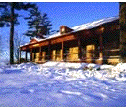|
Reynolds Equation and Mixing Length Model Turbulent Flow Between Two Parallel Plates
Logarithmic Friction Law
The velocity defect law and the law of the wall in the inertial sublayer are given as

|
(24)
|

|
(25)
|
Subtracting, we find
 , ,
 , ,
|
(26)
|
with  and and
 known,
equation (26) is the statement of the logarithmic friction law. known,
equation (26) is the statement of the logarithmic friction law.
Pipe Flow
The law of the wall and the velocity defect law are also valid for
turbulent pipe flows. Equations (9) - (26) can be written for pipe flows with the following minor changes:
 , ,
 , ,
|
(27)
|
Here,  is the radius of
the pipe and is the radius of
the pipe and  is the
distance from the wall. For pipe flows, is the
distance from the wall. For pipe flows,
 and equations (24) - (26) become and equations (24) - (26) become
 ,
is valid up to ,
is valid up to
 , ,
|
(28)
|
 , ,
|
(29)
|
 . .
|
(30)
|
|





























 ,
,
 ,
,
 and
and
 known,
equation (26) is the statement of the logarithmic friction law.
known,
equation (26) is the statement of the logarithmic friction law.
 ,
,
 ,
,
 is the radius of
the pipe and
is the radius of
the pipe and  is the
distance from the wall. For pipe flows,
is the
distance from the wall. For pipe flows,
 and equations (24) - (26) become
and equations (24) - (26) become
 ,
is valid up to
,
is valid up to
 ,
,
 ,
,
 .
.